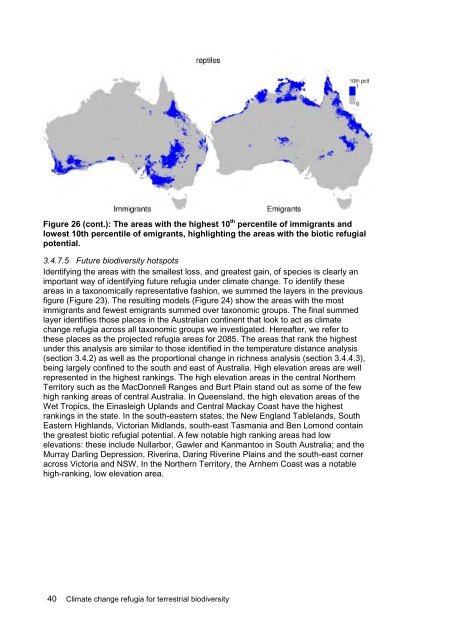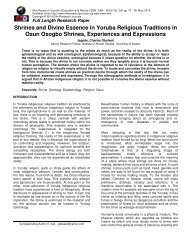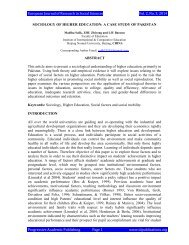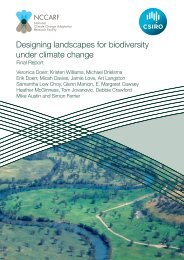Williams-Climate-change-refugia-for-terrestrial-biodiversity_0
Williams-Climate-change-refugia-for-terrestrial-biodiversity_0
Williams-Climate-change-refugia-for-terrestrial-biodiversity_0
You also want an ePaper? Increase the reach of your titles
YUMPU automatically turns print PDFs into web optimized ePapers that Google loves.
Figure 26 (cont.): The areas with the highest 10 th percentile of immigrants and<br />
lowest 10th percentile of emigrants, highlighting the areas with the biotic <strong>refugia</strong>l<br />
potential.<br />
3.4.7.5 Future <strong>biodiversity</strong> hotspots<br />
Identifying the areas with the smallest loss, and greatest gain, of species is clearly an<br />
important way of identifying future <strong>refugia</strong> under climate <strong>change</strong>. To identify these<br />
areas in a taxonomically representative fashion, we summed the layers in the previous<br />
figure (Figure 23). The resulting models (Figure 24) show the areas with the most<br />
immigrants and fewest emigrants summed over taxonomic groups. The final summed<br />
layer identifies those places in the Australian continent that look to act as climate<br />
<strong>change</strong> <strong>refugia</strong> across all taxonomic groups we investigated. Hereafter, we refer to<br />
these places as the projected <strong>refugia</strong> areas <strong>for</strong> 2085. The areas that rank the highest<br />
under this analysis are similar to those identified in the temperature distance analysis<br />
(section 3.4.2) as well as the proportional <strong>change</strong> in richness analysis (section 3.4.4.3),<br />
being largely confined to the south and east of Australia. High elevation areas are well<br />
represented in the highest rankings. The high elevation areas in the central Northern<br />
Territory such as the MacDonnell Ranges and Burt Plain stand out as some of the few<br />
high ranking areas of central Australia. In Queensland, the high elevation areas of the<br />
Wet Tropics, the Einasleigh Uplands and Central Mackay Coast have the highest<br />
rankings in the state. In the south-eastern states; the New England Tablelands, South<br />
Eastern Highlands, Victorian Midlands, south-east Tasmania and Ben Lomond contain<br />
the greatest biotic <strong>refugia</strong>l potential. A few notable high ranking areas had low<br />
elevations: these include Nullarbor, Gawler and Kanmantoo in South Australia; and the<br />
Murray Darling Depression, Riverina, Daring Riverine Plains and the south-east corner<br />
across Victoria and NSW. In the Northern Territory, the Arnhem Coast was a notable<br />
high-ranking, low elevation area.<br />
40 <strong>Climate</strong> <strong>change</strong> <strong>refugia</strong> <strong>for</strong> <strong>terrestrial</strong> <strong>biodiversity</strong>






